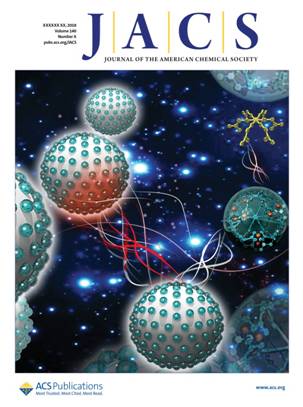Journal of the American Chemical Society (JACS), a top international chemical journal, recently has published, online and on its cover, the latest results on the self-assembly of metallo-organic supramolecular bucky balls, “Highly Stable Spherical Metallo-Capsule From a Branched Hexapodal Terpyridine and Its Self-Assembled Berry-type Nanostructure”, which was from Professor Pingshan Wang and his research group from the School of Chemistry and Chemical Engineering of Central South University. The School of Chemistry and Chemical Engineering of Central South University is the sole correspondence unit of this article, Mingzhao Chen (PhD candidate, 2016), and Jun Wang (graduate student, 2015) from the School of Chemistry and Chemical Engineering are co-first author of this article, and Professor Pingshan Wang is the corresponding author. This is the first time that the study from Central South University is published as a cover article on top international chemical journals. Over the past two years, a series of research findings on the self-assembly of terpyridine metallo-organic monomolecular structures and their functional applications from the group of Professor Pingshan Wang have been published on top international chemical journals, including Nat. Commun. (IF = 12.124, 2017, 15476), Angew. Chem. Int. Ed. (IF = 11.994, 2017, 56, 11450) and JACS (IF = 13.858, 2016, 138, 10041).

In supramolecular chemistry, the self-assembled ultra-large monomolecular structures in three-dimensional (3D) space, benefited by their cavity configurations, are widely applied in host-guest chemistry, molecular recognition, chemical separation, catalytic chemistry, reaction control in cavities, biomedical and other fields, and have become a hot spot in supramolecular chemistry. Due to the strong coordination capability of the terpyridine ligands and the excellent optoelectronic properties and catalytic properties of the terpyridine metal complexes, it is more meaningful to use terpyridine ligands to prepare 3D supramolecular structures. However, up to now, the assembly of terpyridine-based 3D symmetric supramolecular structures has been very limited and their applications are negligible. These limitations are often due to the following challenges: (1) the 3D supramolecular structures with geometrical aesthetics are limited, and difficult to synthesize; (2) the terpyridine coordination is a 180origid connection, resulting in a relatively fixed metal coordination mode, limited source of ligands, and less modes of assembly changes; and (3) the studies on the design and synthesis of suitable ligands to build 3D supramolecular structures in order to achieve their functionality are still less.

Coordination-oriented self-assembly is one of the important ways to prepare novel 3D metallo-organic supramolecular structures. The group of Professor PingshanWang first synthesized a novel organic ligand containing six uncoordinated dendrimer terpyridine, which was then subjected to coordination self-assembly with Zn2+to quantitatively obtain a Bucky spherical supramolecular “nano-capsule” via one-step reaction. This is by far the first report on the metallo-organic supramolecular host having fixed dimension and configuration and built from a rigid hexacoordinated terpyridine organic ligand, andis the first report that the non-anionic receptor molecule is selectively encapsulated by terpyridine-based 3D “capsule”. In this article, coronene was chosen as the receptor molecule to study its host-guest chemical interactions. The increase of the coordination number results in high stability of the 3D spherical structure, making it more compact and easier to encapsulate guest molecules. Therefore, it has a good application prospect in the fields of host-guest recognition, drug release, nano-materials and catalysis chemistry.
In addition, in the article, it was observed that the Bucky molecular sphere can further experience layered self-assembly. The initial "nanosphere" of only about 4 nm can be further assembled into a larger "berry-like" nanostructure of about 30 nm.

This study provides a new idea for the synthesis of novel functionalized metallo-organic 3D "nanocapsules" with simple and efficient assembly (quantitative yield, without the need for complicated column separation), and expands the applications of the terpyridine coordination system as molecule capsules and hierarchical self-assembly model. This significant research was supported by the Analysis and Testing Center of Central South University for NMR and TEM testing.
(URL:http://pubs.acs.org/doi/abs/10.1021/jacs.7b10707)
Source: School of Chemistry and Chemical Engineering











